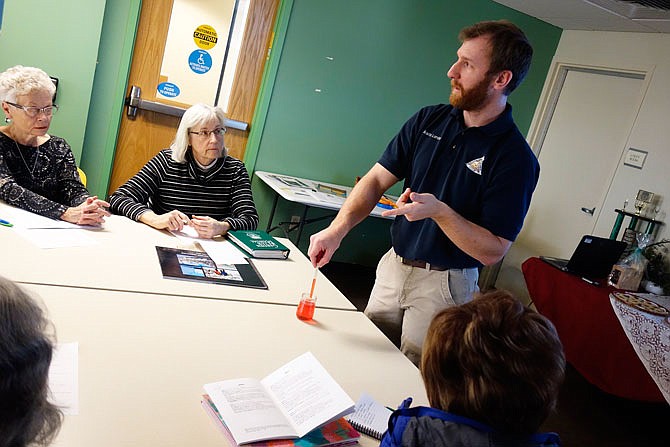Austin Lambert, a naturalist at the Runge Conservation Nature Center, has tracked birds from Missouri to Alaska, performing blind studies and field research.
He takes his knowledge to schools and other groups, and recently, he spoke to the Fulton Garden Club's members and guests.
"One of my favorite things is to learn, and the best way to learn is by doing demonstrations," he said.
His subject: hummingbirds - is perhaps the most interesting avian species of all.
"Hummingbirds are one of the most unique kinds of birds in the world," Lambert said.
It's easy to prove just by looking at numbers.
1,260: The number of heartbeats per minute. Human hearts beat about 70 times per minute.
250: The number of breaths per minute, at rest. More if moving.
53: The number of wing beats per second.
344: The number of hummingbird species in north, central and south America.
"Hummingbirds are only found in America," Lambert added, from southeast Alaska to southern Chili. "They're the smallest bird in the world."
The smallest of the small is the bee hummingbird, weighing 2 grams. It lives in the Cuban Archipelago.
The largest is the giant hummingbird, about the size of a cardinal and two-times larger than the next largest hummer. They live in the fringes of the Andes Mountains.
Lambert said most hummingbird species live in the the tropics, and only 17 species breed in North America. Eastern North America only has one breeding species: the ruby-throated hummingbird.
Hummingbird species appearances vary widely.
"They are different colors, different shapes. They have different beak lengths and shapes," Lambert said. "There's just a huge, huge diversity."
They are keenly adapted to their environments, and everything about them has evolved along with the flowers on which they feed - such as trumpet vines.
"We have all sorts of pollinators that have evolved as well," he added.
Lambert said hummingbirds live very fast-paced lives, and they are very adapted to that. In other words: There's not much time to stop and smell the flowers.
"They're unique athletes," Lambert said. "They can twist and turn to keep up with flowers blowing about in the wind."
They can hover, fly upside down and backward, and go in any direction. They reach top speeds of 60 miles per hour.
"They have flexible shoulders," Lambert said, illustrating how their wings can go in figure 8 patterns. "Their wings are unlike any other bird."
They don't suck nectar. Instead, hummingbirds have enormously long tongues with forks at the end, and with them, they can create a pump-like vacuum to ingest nectar.
Scientists are still trying to figure out hummingbird details, Lambert added.
"They used to think they buried themselves in the bottom of lakes to hibernate," he said.
People also thought they hitched rides on the backs of migrating geese to get to warmer winter climates in southern Mexico and Central America.
These scientists were wrong. Hummingbirds fatten up, especially in the fall, and then they fly. Some fly 500 miles over the Gulf of Mexico, a 20-hour journey for a hummingbird humming along at 25 miles an hour or thereabouts.
"The females weigh about 3 grams and the males are smaller, about 21/2 grams," Lambert said. "They lose half their body weight migrating."
And hummingbirds are super fragile in their first year, he added.
"It's very tough being a little hamburger flying around," he said.
Hummingbirds can be meals for small hawks, some spiders and preying mantis insects. Harsh weather kills many of the young hummers, as many crash themsevles into windows.
But if they make it through that first year, they can live to ripe old ages. Through banding programs, Lambert said hummingbirds have been found at 12 years of age.
"It's hard to age a hummingbird after they become an adult; it looks the same the rest of its life," he added.
Hummingbirds should start reappearing on their northward migration in April. They only nest during the summer months in North America, and may have two or three clutches of babies in that time period. Their tiny nests can be found in any type of tree, as high as 5-20 feet from the ground.
So, how to help? Especially when they are working themselves north in the spring and south in the fall, setting out hummingbird feeders is huge. Also, plant native nectar sources and even create hummingbird gardens.
"The standard for making nectar is one part sugar to four parts water," Lambert said, adding people should leave out the red dye. "Use sugar only. Artificial sweeteners can cause (diseases)."
If people find their hummingbird feeders attracting unwanted wasps and other stinging insects, add more water. Use Dawn dishwashing liquid to clean your feeder once a week, alternating with bleach the next week.
They also like misting-type fountains, Lambert said.
"You'll see this little jewel flying around with other little jewels," he added.
Runge Conservation Nature Center is operated by the Missouri Department of Conservation in Jefferson City. Upcoming programs include the Great Backyard Bird Count (8-11:30 a.m. Saturday), a salamander prowl and upcoming native plant sale. To learn more, visit nature.mdc.mo.gov/discover-nature/places/runge-nature-center.

